Detailed description of EPDM Rubber Compound
2024-06-29
EPDM (Ethylene Propylene Diene Monomer) rubber compound is a versatile material known for its excellent weather resistance, durability, and thermal stability. Here’s a detailed description of what typically characterizes EPDM rubber compound:
1. Composition:
- Base Polymer: EPDM is a synthetic rubber derived from the polymerization of ethylene, propylene, and a diene monomer.
- Additives: Various additives are incorporated into the compound to enhance specific properties such as UV resistance, flexibility, and thermal stability.
- Fillers: Fillers like carbon black or silica are added to improve mechanical properties such as tensile strength and tear resistance.
2. Properties:
- Weather Resistance: EPDM rubber is highly resistant to weathering, ozone, and UV exposure, making it suitable for outdoor applications where exposure to sunlight and harsh environmental conditions is common.
- Temperature Resistance: Exhibits excellent heat resistance and can withstand temperatures ranging from -50°C to +150°C (-58°F to +302°F) without significant degradation.
- Chemical Resistance: Resistant to many chemicals, acids, and alkalis, making it suitable for use in industrial and automotive applications.
- Electrical Insulation: EPDM is an effective electrical insulator, providing protection against electrical conductivity and breakdown.
3. Applications:
- Automotive Industry: Used in door seals, window seals, weatherstripping, and hoses due to its flexibility and weather resistance.
- Building and Construction: EPDM is used in roofing membranes, window seals, expansion joints, and gaskets.
- Electrical Industry: Insulation for wires and cables due to its electrical properties.
- General Industrial Use: Gaskets, O-rings, conveyor belts, and various molded rubber parts.
4. Processing:
- Extrusion and Molding: EPDM rubber can be processed through extrusion or molding techniques to create profiles, seals, and custom shapes.
- Vulcanization: Vulcanization is a critical step in the manufacturing process where the rubber compound is heated with sulfur or peroxide to cross-link the polymer chains, enhancing its mechanical properties and durability.
5. Color and Surface Finish:
- Color: EPDM rubber compounds are available in a range of colors, typically black, but can be customized with pigments for specific applications.
- Surface Finish: The surface of EPDM rubber can be smooth or textured, depending on the manufacturing process and application requirements.
6. Environmental Considerations:
- Recyclability: EPDM rubber is recyclable and can be reprocessed into new products or used as an additive in other rubber compounds.
- Durability: Known for its long service life and resistance to aging, EPDM contributes to sustainable solutions in various industries.
EPDM rubber compound’s combination of physical properties, chemical resistance, and environmental durability makes it a preferred material for a wide range of industrial, automotive, and construction applications where resilience and longevity are essential.



